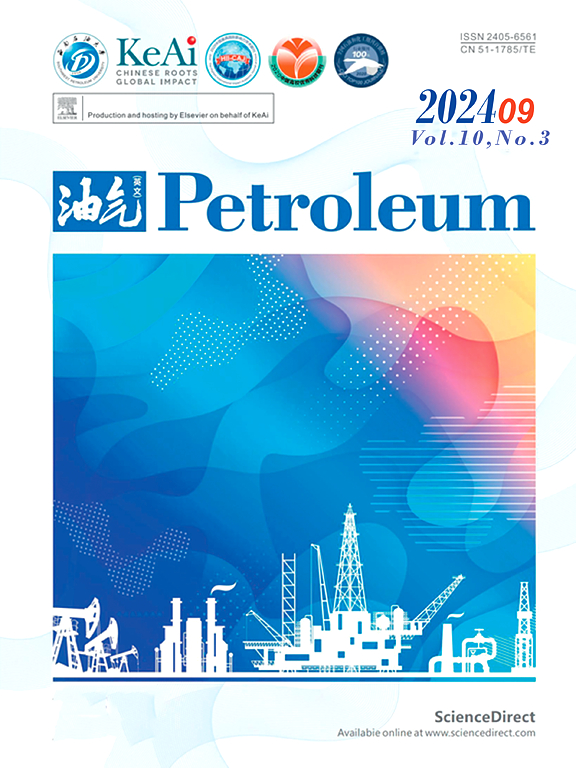Effect of monovalent/divalent ions and SiO2-based nanocomposite dosage on thermochemical stability of HPAM polymeric solutions
IF 4.2
Q2 ENERGY & FUELS
引用次数: 0
Abstract
This study evaluated the effect of monovalent and divalent ions and the dosage of a SiO2-based nanocomposite on the thermochemical stability of HPAM polymeric solution. Chelating amine–functionalized NPs (AFNPs) were used to enhance the thermochemical stability of HPAM based on capturing monovalent/divalent ions after seven days at 70°C. Different polymer solutions prepared with calcium chloride dihydrate (CaCl2·2H2O) at 2000 mg/L and sodium chloride (NaCl) at 10000 mg/L, and two different dosages of HPAM (1000 and 2000 mg/L) were assessed in the presence and absence of AFNPs at dosages of 200, 500 and 1000 mg/L. The nanocomposite was characterized by N2 adsorption, Fourier-transformed infrared spectrophotometry (FTIR), thermogravimetric analysis (TGA), dynamic Light Scattering (DLS), and Zeta potential (ZP). Stability tests over time confirmed the positive effect of nanocomposite on increasing the thermochemical stability of polymer solutions. Results revealed that adding 0, 200, and 500 mg/L of nanocomposite to the polymeric solution at 1000 mg/L of HPAM, 10000 mg/L of NaCl, and 2000 mg/L of CaCl2·2H2O led to the viscosity reductions of 73.5%, 18%, and less than 1% after 7 days (70°C), respectively. Nanocomposite at 200 mg/L reduces the polymer degradation in the presence of the two salts evaluated separately, i.e., 20% for 10000 mg/L of NaCl and 15% for 2000 mg/L of CaCl2·2H2O. The adsorption tests on AFNPs and SiO2 NPs concluded that AFNPs had higher adsorption of cations in comparison to SiO2 NPs and that greater adsorption of cations is related to a reduction in polymer degradation.
单价/二价离子和基于二氧化硅的纳米复合材料用量对 HPAM 聚合物溶液热化学稳定性的影响
本研究考察了一价离子和二价离子以及sio2基纳米复合材料的用量对HPAM聚合物溶液热化学稳定性的影响。螯合胺功能化NPs (AFNPs)用于在70℃下捕获7天后的单价/二价离子,以增强HPAM的热化学稳定性。以二水氯化钙(CaCl2·2H2O)浓度为2000 mg/L、氯化钠(NaCl)浓度为10000 mg/L、HPAM浓度为1000和2000 mg/L制备不同聚合物溶液,在AFNPs浓度为200mg /L、500mg /L和1000mg /L存在和不存在的情况下进行了研究。采用N2吸附、傅里叶变换红外光谱(FTIR)、热重分析(TGA)、动态光散射(DLS)和Zeta电位(ZP)对纳米复合材料进行了表征。随着时间的推移,稳定性测试证实了纳米复合材料对提高聚合物溶液的热化学稳定性的积极作用。结果表明,在HPAM浓度为1000 mg/L、NaCl浓度为10000 mg/L、CaCl2·2H2O浓度为2000 mg/L的条件下,加入0、200和500 mg/L的纳米复合材料,7天后(70°C)粘度分别降低73.5%、18%和小于1%。在200 mg/L NaCl和2000 mg/L CaCl2·2H2O两种盐分别存在时,纳米复合材料降低了聚合物的降解率,即10000 mg/L NaCl和2000 mg/L CaCl2·2H2O分别为20%和15%。对AFNPs和SiO2 NPs的吸附试验表明,与SiO2 NPs相比,AFNPs对阳离子的吸附量更高,并且阳离子吸附量的增加与聚合物降解的减少有关。
本文章由计算机程序翻译,如有差异,请以英文原文为准。
求助全文
约1分钟内获得全文
求助全文
来源期刊

Petroleum
Earth and Planetary Sciences-Geology
CiteScore
9.20
自引率
0.00%
发文量
76
审稿时长
124 days
期刊介绍:
Examples of appropriate topical areas that will be considered include the following: 1.comprehensive research on oil and gas reservoir (reservoir geology): -geological basis of oil and gas reservoirs -reservoir geochemistry -reservoir formation mechanism -reservoir identification methods and techniques 2.kinetics of oil and gas basins and analyses of potential oil and gas resources: -fine description factors of hydrocarbon accumulation -mechanism analysis on recovery and dynamic accumulation process -relationship between accumulation factors and the accumulation process -analysis of oil and gas potential resource 3.theories and methods for complex reservoir geophysical prospecting: -geophysical basis of deep geologic structures and background of hydrocarbon occurrence -geophysical prediction of deep and complex reservoirs -physical test analyses and numerical simulations of reservoir rocks -anisotropic medium seismic imaging theory and new technology for multiwave seismic exploration -o theories and methods for reservoir fluid geophysical identification and prediction 4.theories, methods, technology, and design for complex reservoir development: -reservoir percolation theory and application technology -field development theories and methods -theory and technology for enhancing recovery efficiency 5.working liquid for oil and gas wells and reservoir protection technology: -working chemicals and mechanics for oil and gas wells -reservoir protection technology 6.new techniques and technologies for oil and gas drilling and production: -under-balanced drilling/gas drilling -special-track well drilling -cementing and completion of oil and gas wells -engineering safety applications for oil and gas wells -new technology of fracture acidizing
 求助内容:
求助内容: 应助结果提醒方式:
应助结果提醒方式:


